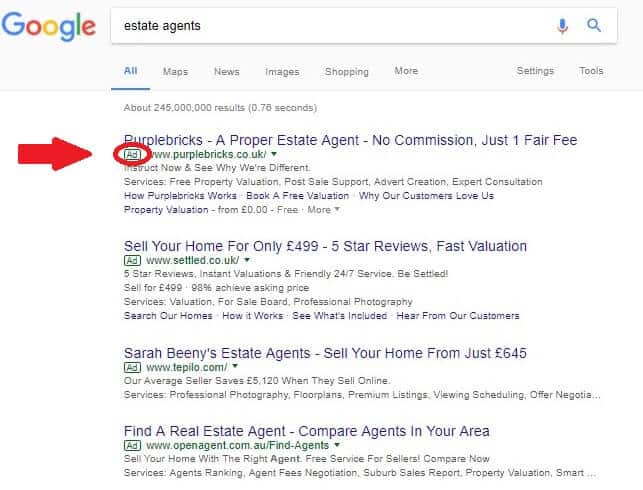What is Google AdWords? Should You Use It?
Simply put, AdWords is Google’s advertising system. It allows businesses to feature ads within the Google search results.

Companies can, therefore, bid to show their website at the top of search results for their desired keywords and are charged on a pay per click basis. AdWords is a digital marketer’s strongest instrument for SEM.
What is SEM, do I need it & does it include SEO?
SEM stands for search engine marketing. Technically SEM can cover all digital marketing that takes place within search engines. This includes both PPC and SEO.
Since almost everyone with a computer uses search engines regularly, all businesses should have SEM feature highly in their digital marketing efforts, in order to reach customers who are actively looking for your services online.
It is easy to become confused around the question of ‘what is SEM?’. This is because digital marketers use the term differently. While the original term did apply to both SEO and PPC, more recently many industry insiders use the term to purely refer to paid search.
SEM may or may not incorporate SEO, depending on which digital marketer you ask but both uses of the term are technically accurate. As the most sophisticated PPC platform, Google AdWords is central to SEM by either definition.
PPC stands for pay per click but what is pay per click advertising?
PPC is essentially the purchase of website visitors via pay per click ads. The advertiser is only charged when a click occurs.
There can also be some confusion around the question of what is PPC because it is often discussed in the context of paid search, however, PPC ads can be found throughout the web.
You have probably encountered PPC advertising on websites and social media before as visual advertisements to external sites.
Any ad on the web that is charged on a pay per click basis counts as pay per click advertising.

What is pay per click advertising in search? Paid search is just like any other PPC advertising except the ads are within search engine results.
Google AdWords is the most popular PPC platform with over 70% market share but there are other successful platforms. Bing ads and Yahoo advertising are Google’s main competitors.
These PPC platforms may be owned by search engine companies but their PPC technology is not limited to paid search because they also possess display networks. You can, therefore, use Google AdWords for all kinds of PPC ads, including those found on other websites.
When we ask what is pay per click advertising, we can be referring to a major part of SEM but it also goes beyond this and can take place on social platforms and via individual publishers as well as on search engines.
The ever-growing popularity of Google AdWords
What does Google AdWords do that makes it such a successful PPC advertising platform?
Google AdWords owes much of its success to the Google search engine’s popularity. It can, therefore, reach the most users, which is of great benefit to businesses.
Despite Google not being the first search engine, AdWords was the first of the 3 major search advertising platforms to be launched. This made Google AdWords ahead of the game when it came to PPC innovation. Bing and Yahoo have since struggled to keep pace with Google AdWords’ advanced technology.
Google AdWords’ popularity has grown exponentially since its launch in 2000 with only 350 advertisers. Now it boasts over a million advertisers and Google rakes in tens of billions of dollars from AdWords every year.
The sheer number of people using Google makes AdWords an invaluable part of businesses’ digital marketing efforts. There are now over 3 billion searches performed on Google every day. Naturally, this has fuelled its popularity among businesses looking to tap into the digital market.
The interest in Google AdWords has increased dramatically over the last ten years and more businesses adopt AdWords marketing each day:

Types of Google Ads
What is Google ads?
AdWords is Google’s PPC platform but Google ads are the actual adverts created by you, the advertiser, that users will encounter.
Whatever your business model and whoever your audience are, there are Google ads to suit your needs.
Google AdWords grants you advertising access to:
The search network
The display network
The shopping network
YouTube
With each network there are different types of Google ads to choose from.
1. Search network Google ads
This is PPC advertising within the Google search engine. Within this network you can use:
Standard text ads – Simple Google ads targeted by keyword. A click takes the user to your site.

Call only ads – Similar to standard text ads but with the aim of generating phone calls to your business. A click allows the users to ring your business rather than head to your site.

RLSA ads – Remarketing lists for search ads. Text ads in search, targeted at previous visitors to your site.
Dynamic search ads – Standard text ads but instead of targeting by keyword, Google scans your site to match content to the most relevant queries and dynamically creates suitable ad headlines.
App promotion ads – Ads which run on the search network for mobile devices to promote app installs and targeted to relevant mobile operating systems for your app.

2. Display network Google ads
On the display network you can create an array of imagery rich ads to appear on other websites. Within this network you can use:
Standard display ads – Image or text ads displayed on websites across the Google display network.

Rich media ads – Similar to image ads but expandable with interactive features to promote engagement.
Remarketing ads – Image ads targeted at previous visitors to your website as they browse other sites on the GDN.
Dynamic ads – Google ads created using templates and targeted at previous visitors to your website. Ads are auto generated based on specific products or service pages in which users expressed an interest in on your site.
Gmail ads – Google ads which appear in an email format and targeted at users’ Gmail inboxes.

App promotion ads – Visual app install ads shown in apps similar to yours.
Video ads – Video ads created in YouTube can be displayed across the GDN and Google Partner sites as well as on YouTube.
3. Shopping network Google ads
The shopping network is perfect for e-commerce advertisers and users who want to browse and compare visual products easily from search. Within this network you can use:
Standard shopping ads – By linking Google AdWords to a Google Merchant Center account Google can create visual ads for you and target them to relevant queries automatically using your product data sheet.

Remarketing ads for Google shopping – You can also target shopping ads to those who have visited your website before.
YouTube ads
Google’s acquisition of YouTube allows advertisers to expand their PPC efforts onto the world’s most popular video sharing channel. Within this network you can use:
True View ads – Video ads that show before, after or during another video on YouTube. They can be skipped after 5 seconds.

Discovery ads – Ads promoting videos within YouTube search or alongside other videos.

Bumper ads – Six second non-skippable video ads that show within other videos on YouTube.
Text or image overlay ads – Text or image ads appearing as overlays on other YouTube videos. They are created as part of a display network campaign but specifically targeted at the YouTube platform.
Video shopping – Video ads featuring shopping cards to promote a purchase. These are created by linking a video ad campaign with a Google Merchant Center account.

Remarketing ads – Video ads targeted at remarketing lists. You can target those who have visited your site before while they are on YouTube or users who have watched your videos before or visited your channel before.
Dynamic video remarketing for shopping ads – Video ads targeted at users who have visited your site before with shopping cards specific to products they showed an interest in.
App promotion – True View ads that allow app installation directly from the video ad and displayed on YouTube mobile and tablet apps.
Who is Google AdWords for?
We have now firmly established the answers to ‘what is Google AdWords?’ and ‘what does Google AdWords do?’ but who is it for?
If used correctly AdWords can benefit almost everyone. Practically every business, organisation or individual with a website can utilise AdWords to drive greater traffic numbers. Whether you are a profit driven B2C or B2B business, a charity or even a person looking to promote their blog, AdWords can deliver the visitors quickly.
Google AdWords is especially useful for websites who don’t yet have an adequate presence in search via SEO. Many businesses will require both organic search marketing and PPC advertising to achieve the greatest coverage.
It is essential to businesses who want to target specific audiences and those who need to expand their audience pool.
How to open a Google AdWords account
Before you get started with Google AdWords you will need a Google account. If you do not have one go to www.google.com/gmail. Fill in the required information:

Now you have a Gmail address. This is the email and password you will use for your Google AdWords account.
Head to www.adwords.google.com. Sign in with your Gmail and password and then enter your website domain name into the required field and click continue:

Google AdWords will walk you through creating a first campaign. You can change all of these settings later if you aren’t happy with them or opt to skip the guided setup:





Whether you choose guided set up or to skip you must fill out your country, time zone and currency correctly as this cannot be changed later.

Why PPC advertising is important
Now that you understand what PPC marketing is, it’s time to get to grips with why it is so important to your digital marketing efforts.
PPC advertising is the best way to increase your traffic rapidly and market your business to a massive audience who are actively in need of your services.
PPC has repeatedly proven itself to be one of the most profitable marketing channels when it comes to generating higher ROI.
By using PPC you will be able to:
- Gain visibility in search for relevant keywords straight away
- Reach a larger audience
- Market to searchers with high intent
- Use high-tech audience targeting
- Gather useful data
- Support your slow growing SEO efforts
Why PPC advertising can be challenging
PPC advertising is an extremely powerful digital marketing device but not without its challenges.
As the most popular PPC advertising platform Google AdWords is now also very competitive. This means the cost of keyword bids has been rising and for many industries Google AdWords can be expensive.
Google’s interface can also seem very complex to the inexperienced. It is common for untrained advertisers to waste their budgets due to misunderstanding the interface.
To utilize Google AdWords effectively and limit costs it takes strategic planning and finesse.
If you’re currently struggling with your own PPC campaigns or looking for a PPC management service, get in touch for a no-obligation consultation call or a free Audit.
